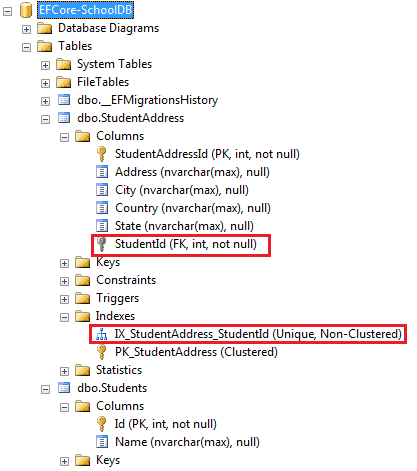One-to-One Relationship Conventions in Entity Framework Core
Entity Framework Core introduced default conventions which automatically configure a One-to-One relationship between two entities (EF 6.x or prior does not support conventions for One-to-One relationship).
In EF Core, a one-to-one relationship requires a reference navigation property at both sides. The following Student and StudentAddress entities follow the convention for the one-to-one relationship.
public class Student { public int Id { get; set; } public string Name { get; set; } public StudentAddress Address { get; set; } } public class StudentAddress { public int StudentAddressId { get; set; } public string Address { get; set; } public string City { get; set; } public string State { get; set; } public string Country { get; set; } public int StudentId { get; set; } public Student Student { get; set; } }
In the example above, the Student entity includes a reference navigation property of type StudentAddress and the StudentAddress entity includes a foreign key property StudentId and its corresponding reference property Student.
This will result in a one-to-one relationship in corresponding tables Students and StudentAddresses in the database, as shown below.

EF Core creates a unique index on the NotNull foreign key column StudentId in the StudentAddresses table, as shown above. This ensures that the value of the foreign key column StudentId must be unique in the StudentAddress table, which is necessary for a one-to-one relationship.
Note: Unique constraint is supported in Entity Framework Core but not in EF 6 and that's why EF Core includes conventions for one-to-one relationship but not EF 6.x.
Use Fluent API to configure one-to-one relationships if entities do not follow the conventions.